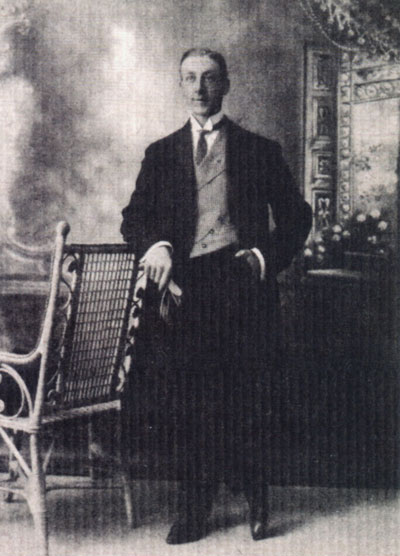
A University of Pennsylvania graduate born in Philadelphia played a largely unrecognized but important part in recovering and promoting Peru’s rich pre-Columbian past. While most people probably have not heard of Albert Giesecke, for he wrote sparingly in English and achieved his goals mostly behind the scenes, he had a major hand as a young man in the discovery of Machu Picchu, though he got none of the credit. Attribution as its discoverer went instead to Hiram Bingham (1875–1956), who reached Machu Picchu on July 24, 1911, and who spun a discovery narrative crediting himself that has now become legendary. Machu Picchu has since become the most visited archaeological site in the Western Hemisphere and the foremost tourist destination in South America, but Albert Giesecke’s role in its story is simply one part of a remarkable life spent mostly in Peru. This appreciation of an extraordinary man comes from reading his papers, scrutinizing books by and about Hiram Bingham, and learning bit by bit through several decades the 20th-century history of Cuzco.
Albert Giesecke’s Peruvian connection started in 1909 when that country’s ambassador in Washington, D.C. asked Penn Professor Leo Rowe of the Department of Political Science to recommend a young scholar to work for a year with the Ministry of Education in Lima. Peru’s president at that time, Augusto Leguía, sought to modernize his country by importing educational ideas and technology from abroad. Rowe knew Giesecke as a student. In addition to his undergraduate degree from Penn, Giesecke also did advanced work in economics and political science at the Wharton School, spent a year studying in Europe, and in 1908 earned a Ph.D. in economics at Cornell University. In 1909 he was back at Penn teaching economics. Open to new experiences, Giesecke accepted this foreign assignment, but little did he know that circumstances would keep him in Peru for the rest of his life.
The son of German immigrants who lived on 19th Street between Walnut and Chestnut Streets in Philadelphia, Giesecke had never been to Latin America. However, one of his teachers at Central High School—then, as now, one of the best public high schools in America—had sparked his early interest in the region, prompting him to study Spanish for two years. Once he reached Peru, his Spanish rapidly became fluent. Nine months into his assignment at the Ministry, President Leguía personally asked him to assume the position of Rector at the National University of Cuzco. A bitter strike had paralyzed this small institution, and the government closed it to prevent further violence. Giesecke, intrigued with the challenge and only 27 years old, plunged into the fray.
Not only did he reconvene classes, but over the next decade he transformed this venerable university, founded in 1692, with its scholastic tradition of abstract debate, into a modern institution focused on the past, present, and future of the Cuzco region. Giesecke led field trips and started a journal, Revista Universitaria, to publish studies on different aspects of the local area. He also founded a town-and-gown geographical society and an academy for the indigenous Quechua language, and he enhanced student life by opening admissions to women, inviting students to lunch, and introducing an extracurricular sports program. By the end of his rectorship, university enrollment had more than tripled.
When Giesecke married Ester Matto, the daughter of an important local family, he quickly became integrated into the social life of Cuzco. From 1912 until 1923, he served on the municipal council, including three years as mayor. He was the main force behind improving Cuzco’s public hygiene. For example, the daily market was moved from the Plaza de Armas to an enclosed building of its own, and he personally supervised the installation of piped water and sewer systems that served Cuzco’s dwellings.
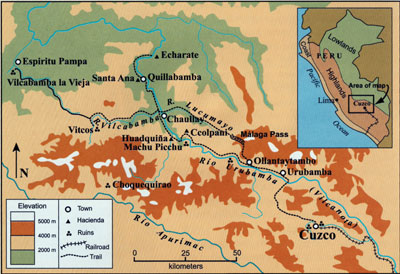
Other city projects also carried his signature. Cuzco’s many dirt streets, dusty in one season and muddy in the other, were paved with cobblestones. With student involvement, the municipality built a vehicular road to the Inca fortress of Sacsayhuaman on a hill above Cuzco. Previously the site’s relative isolation had provided cover for the illegal removal of cut stones for private construction.
In 1912, Giesecke used his knowledge of statistics learned at Cornell to organize a city census. He designed the census forms and engaged 200 student volunteers to fan out door-to-door. In this city of slightly fewer than 20,000 people, domestic service formed the biggest employment category, with many hacendados (estate owners) maintaining households in the city that brought a bevy of servants from their country estates.
Giesecke and the Machu Picchu Story
Soon after Giesecke arrived he sought to learn as much as possible about the large and diverse department of which Cuzco was the capital. In his travels to remote areas, he was fascinated by the pre-Hispanic imprint evident almost everywhere in the highlands. A first-year archaeology course he had taken at Penn gave him the basic foundation on which to frame his observations. Coincidentally, J. Alden Mason, who later went on to become a distinguished Penn professor and archaeologist of Latin America, had been also registered in the same class.
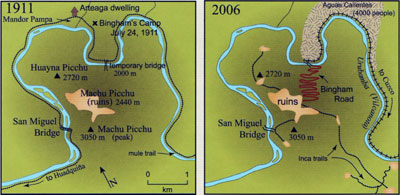
In January 1911, during the height of the rainy season, Rector Giesecke accompanied Braulio Polo, owner of Hacienda Echarate, on a four-day trip on horseback to visit Polo’s estate. Located in the tropical part of the Urubamba Valley, Echarate produced coca, cacao, and coffee, a kind of agriculture that Giesecke had not yet seen. As the two men rode down the Urubamba Valley they passed many ruins visible from the trail. Not surprisingly, the Inca were one of their topics of conversation. Soon after they entered the valley’s gorge they came to a hut at a place called Mandor Pampa. Señor Polo asked the Quechua-speaking inhabitant who sold fodder to passersby about the existence of any ancient ruins in the vicinity. This man, Melchor Arteaga, replied that remains of stone buildings could be found high above the canyon on the river’s other side where he sublet land to other farmers. Given the heavy downpour, Polo and Giesecke agreed that it was not a good time just then to pursue this lead. Expressing hope for a return in the dry season, they continued on their way down the valley to Echarate.
That passing encounter took on unexpected significance six months later when Hiram Bingham arrived in Peru as the leader of an eight-man expedition. Two institutions, Yale University (where he taught Latin American history) and the National Geographic Society, sponsored an ambitious program of mapping, measuring mountain elevations, and looking for Inca remains mentioned in the Spanish chronicles. Bingham’s personal interest was in finding ruins, but he astutely included the other two objectives to appeal to potential underwriters. He made Cuzco the staging point for the expedition’s first phase and spent days lining up mules, buying supplies, and making contacts. Bingham visited Albert Giesecke at his house facing the Plaza San Francisco. Although they had not met before in person, they had exchanged letters about the Inca site of Choquequirao, high above the Apurímac River. Bingham had visited it in 1909, but when Giesecke attempted to do so in 1910, he failed. When the conversation between these two young North Americans turned to the Urubamba Valley in July 1911, Giesecke told Bingham that he and Polo had heard from an Indian about the existence of ruins high above the gorge accessible from a place called Mandor Pampa.
With that crucial piece of information, Bingham set off in that direction. Since he knew precisely where to stop and with whom to speak, he could arrange an exclusive discovery. That none of the other seven expedition members were with him when he reached Machu Picchu was no accident. Following Bingham’s instructions, five of his cohorts had gone with their mules farther down the valley to observe other things. The two expedition members with Bingham at Mandor Pampa did not accompany him on the climb. Only Arteaga, as guide, and Sergeant Carrasco, the Peruvian policeman whom the prefect assigned to the expedition, went with Bingham on the fourhour hike up a steep path from the river. Stone terraces appeared first. Then, farther on, hidden amid the jungle growth, the walls of roofless buildings of exquisitely cut stone. A boy whose family farmed those terraces escorted Bingham around the site. It soon became apparent that this town had been planned as a piece.
Bingham And His Claims
Bingham’s assertion that this place was a “lost city” implied that he was the first to discover it. However, charcoal graffiti found on a wall of the structure made it apparent that other people had been there some years before. In his early articles, Bingham was tentative in claiming to be the first to see it. But as the fame of Machu Picchu grew, his initial reserve dissolved and in his last book, Lost City of the Incas, Bingham became the unqualified discoverer. He did not want to remember it any other way. His self-image was that of an explorer and the goal of an explorer is to discover. Discovery was the one aspect of his Machu Picchu experience that he did not want denied. His failure to acknowledge Giesecke’s key role in telling him where to go was part of that determination to be at center stage of the discovery narrative. During Bingham’s lifetime, archaeologists disputed most of his assertions about the site. For example, Machu Picchu was not “2,000 years old” nor was it a nunnery for the “virgins of the sun.” It is now well established that the Emperor Pachacuti built Machu Picchu in the 15th century as a country estate. To this day many people in Peru and the U.S. criticize Bingham for failing to return to Peru the materials he excavated on his third expedition to Machu Picchu. In 2006, these remain at Yale University and are still a flashpoint of controversy.
Bingham never directly acknowledged in any of his publications Giesecke’s role in the vital transfer of information that led the Connecticut Yankee to find Arteaga at Mandor Pampa and have him be a guide to the ruins. When Giesecke himself visited Machu Picchu in June 1912—a month before Bingham arrived from the U.S. on a follow-up expedition to carry out a full-site survey—he and his Cuzco students found the trail to Huayna Picchu and the eyrie-like Inca constructions built on that other peak above the main Machu Picchu site. Bingham, who considered Machu Picchu to be “his” site to document, never acknowledged Giesecke’s find. For that reason and to thwart treasure hunters, Bingham sought to keep the existence of Machu Picchu secret from anyone in Cuzco until his return in 1912.
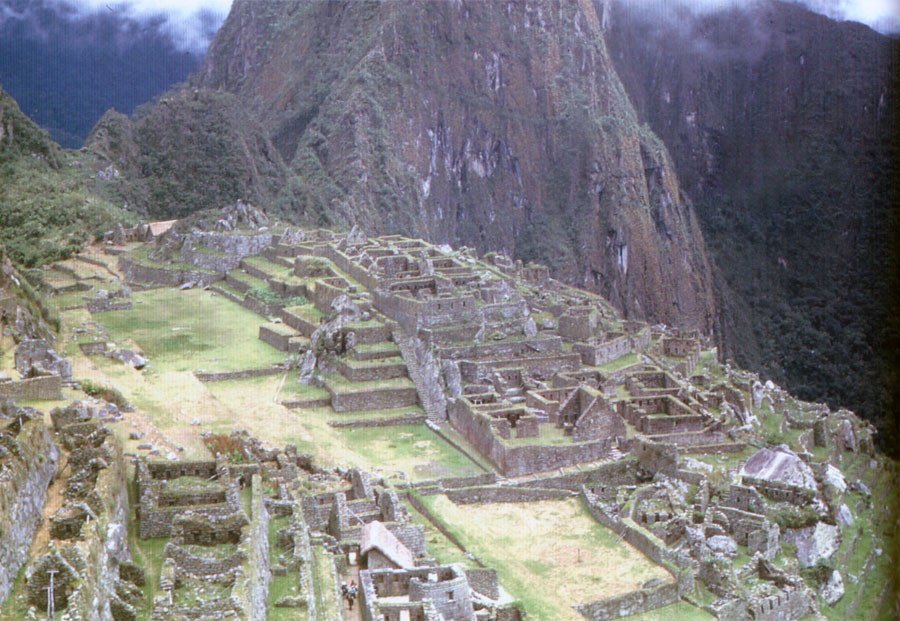
Bingham’s heavy ego also manifested itself much later when he compiled the scientific monograph of his excavations from several expeditions. During the 1920s, his political activities, first as Lieutenant Governor, then as Governor of Connecticut, and later as a U.S. Senator, left him little time to assemble and analyze the site’s data. He therefore approached Philip Ainsworth Means, an accomplished Peruvianist, to prepare the manuscript that was subsequently titled Machu Picchu, a Citadel of the Incas. When Means delivered the completed manuscript that listed himself as co-author, Bingham removed Means’ name from the title page before its publication.
Studying And Preserving Peru’s Past
Giesecke’s own encounter with Machu Picchu energized him to think more deeply about the implications of living in the heart of one of the world’s great ancient civilizations. In a country where looting pre-Hispanic graves had a long tradition, he realized there was a need to save the material evidence of the past. To start an archaeological museum in Cuzco, he persuaded José Lucas Capero, an estate owner, to sell his collection of 3,600 pieces to the university. In 1920, Giesecke went to Lima and secured the financial commitment from President Leguía to complete the purchase. Giesecke also played a crucial role in negotiating an exchange between Victor Larco Herrera and the Peruvian government. Señor Larco, owner of a large sugar estate on the north coast, exchanged his fine collection of pre-Columbian ceramics for a parcel of land on Lima’s main plaza. That collection of 38,000 pieces subsequently formed the core of the new National Museum of Archaeology and Anthropology, founded in 1945.
His efforts to engage a North American university to start an archaeology training school in Cuzco were less successful. After Bingham told him flatly that Yale could not do it, Giesecke contacted several other universities, including his alma mater Penn. At the time, no institution was able to commit itself. But in the early 1940s, Giesecke successfully requested support from Axel Wenner-Gren, who agreed to fund an archaeology program led by the then Harvard doctoral student John H. Rowe. Giesecke also persuaded Paul Fejos, Director of Anthropological Research for the Viking Fund (later the Wenner-Gren Foundation), to survey Inca sites south of Machu Picchu.
In 1923 Giesecke, concerned about his children’s education and satisfied with the work he had achieved in Cuzco, decided to return to the U.S. He never made it. For a second time, the Peruvian government coaxed him into a new and bigger responsibility, this time as Director General of Public Education headquartered in Lima. In that post he traveled widely around the country and gained a depth of knowledge about Peru that few people possessed before or since. Following that seven-year assignment, he again prepared to return to the U.S., but the American Embassy in Lima intervened, offering him a key advisory position. His performance in that role was so effective that in 1951 he received the Distinguished Service Award of the U.S. Department of State. In the same year, the University of Pennsylvania awarded him an honorary doctorate of laws.
In 1938, on behalf of the National Museum in Lima, Giesecke became involved in the re-excavation and reconstruction of Pachacamac. First described by Max Uhle in a Penn Museum monograph in 1903, Pachacamac was a sacred site for a succession of Peruvian cultures over many centuries. In the storerooms that crowned the Inca-constructed Temple of the Sun, Giesecke discovered food and cloth and the intact carved wooden idol that Hernando Pizarro mentioned in his 16thcentury chronicle of the Spanish pillage of the sanctuary. With these archaeological treasures, he founded an on-site museum.
Giesecke perceived earlier than anyone else that the preColumbian past could be a magnet for tourism. In 1924 he published the first tourist guide to Cuzco Department. His comments about Machu Picchu advised readers to contact Señor Arteaga if they wanted to visit the site and to have him construct a makeshift bridge to cross the roiling Urubamba rapids. Giesecke also foresaw how aviation could overcome barriers posed by difficult land travel. In the 1920s he helped plan the landing field that was the forerunner of the Cuzco airport. The emergence of regular air service in the 1950s became the preferred way for visitors to travel from Lima to the Imperial City.
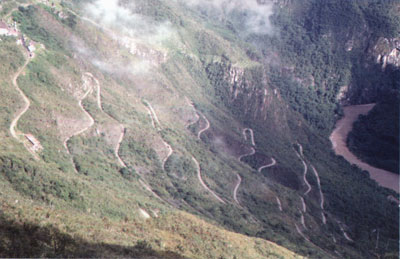
Even from his post in Lima, Giesecke later maintained close involvement with Cuzco and Machu Picchu. In 1934 the narrow-gauge railroad finally reached the spot in the Urubamba gorge directly below the ruins. Henceforth large numbers of tourists could reach the site by train and a mule-back ride up the last 400 m of the steep trail. Giesecke was the chief promoter of the plan to construct the tourist hotel next to the ruins that for years was the only place visitors could stay the night. In 1948 the government built a vehicular road from the bottom of the gorge to the ruins. Bus shuttles from the train station below now allowed tourists a three-hour visit and a return to Cuzco on the same day. To inaugurate this “Hiram Bingham Road,” Giesecke successfully lobbied the Peruvian government to invite the Connecticut Yankee and his second wife. This was the first and only time Bingham returned to Peru since the bitter dispute about his supposedly illegal removal of materials from Machu Picchu’s tombs during his 1915 expedition.
Don De Gentes
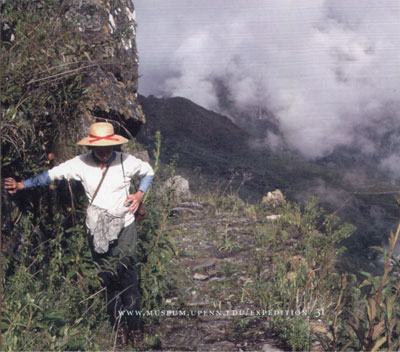
The combination of walls of cut stone, colorful vegetation, clouds and mist, and perfect stillness create a place of utter charm. Panoramas of distant peaks contrast with close-up details to provide an inimitable mix of scales of vision.
Albert Giesecke’s ability to further the common good during his many years in Peru may be largely attributed to his pragmatic attitude for getting things done and his good interpersonal skills, or “don de gentes” in Spanish. He used quiet diplomacy to resolve conflict and did not condescend. Only after Bingham’s death did Giesecke emend the standard narrative of the discovery of Machu Picchu. Even then, he never insisted on recognition for his own key role. Over the years, he responded with grace to Bingham’s many and sometimes imperious requests. On several occasions he took the initiative to honor Bingham. The two men, however, operated from quite different bents of mind. If Bingham remembered his past as a drama in which he was the lead player, Giesecke saw his own focus as helping to build institutions for the benefit of all.
Giesecke’s life also leads one to think about the values of a liberal education. Economics may have been his field of expertise, but his wide interests in Peru grew out of the complementary knowledge he acquired as an undergraduate at Penn. Work in sociology, political science, geography, history, and especially archaeology provided concepts and frameworks for understanding his Peruvian milieu and enabled him to take action on various fronts. More than half a century of residence in country and a range of responsibilities deepened his knowledge of and respect for his adopted country and its past.
Albert A. Giesecke was Philadelphia’s noble gift to Peru. It is there where he died in 1968 and where his descendants have continued a legacy of commitment and service.
Bingham, Alfred. Portrait of an Explorer: Hiram Bingham, Discoverer of Machu Picchu. Ames, IA: Iowa State University Press, 1989.
Bingham, Hiram. Machu Picchu, a Citadel of the Incas. New Haven, CT: Yale University Press, 1930.
Bingham, Hiram. Lost City of the Incas: The Story of Machu Picchu and Its Builders. New York: Hawthorne Press, 1948.
Burger, Richard L., and Lucy Salazar, eds. Machu Picchu: Unveiling the Mystery of the Inca. New Haven, CT: Yale University Press, 2004.
Gade, Daniel W. Plants, Man and the Land in the Vilcanota Valley of Peru. The Hague: Junk, 1975.
Gade, Daniel W. Nature and Culture in the Andes. Madison, WI: University of Wisconsin Press, 1999.
Uhle, Max, and Izumi Shimada. Pachacamac: Archaeology: Retrospect and Prospect. Philadelphia, PA: University of Pennsylvania Museum of Archaeology and Anthropology, 1991 [1903].
